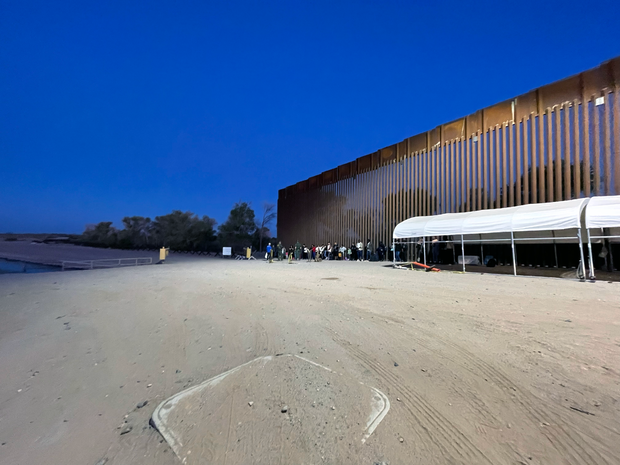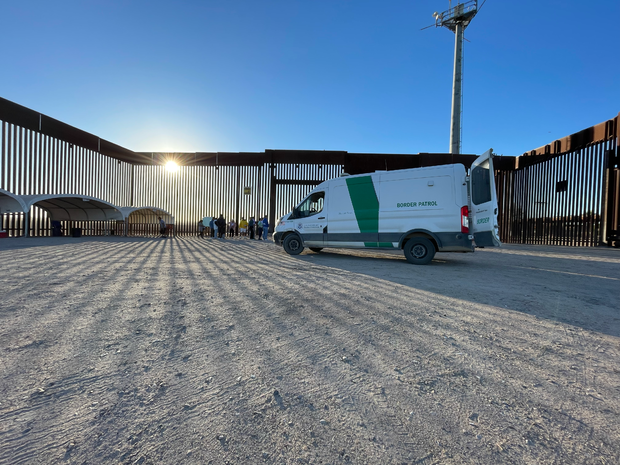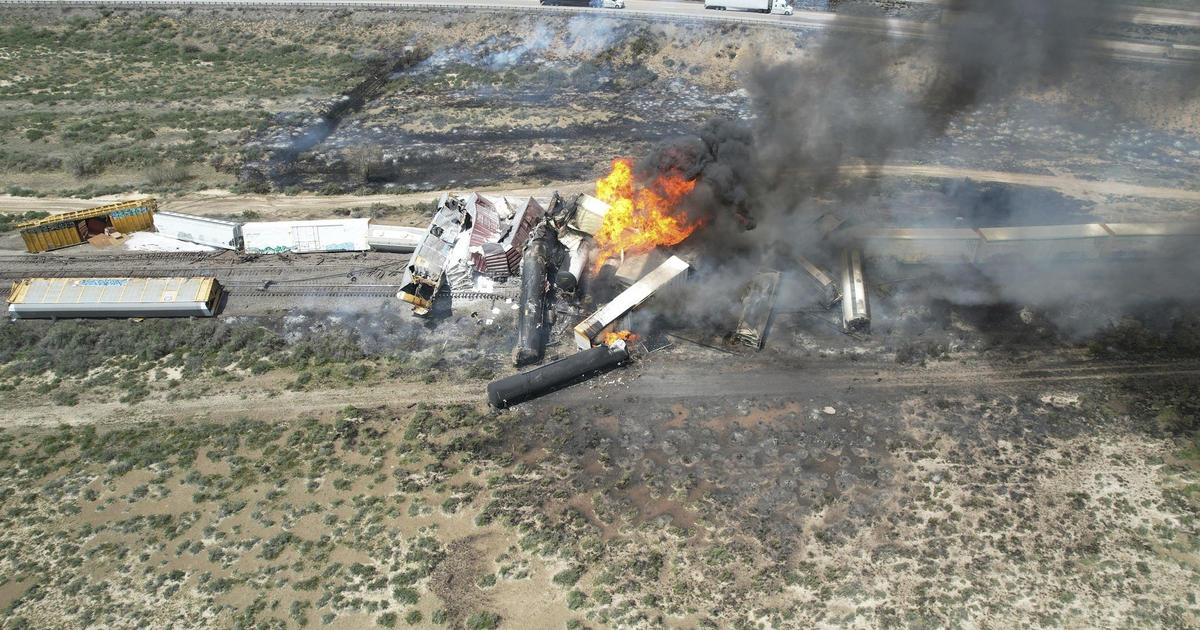Crossings along U.S.-Mexico border jump as migrants defy extreme heat and asylum restrictions
Yuma, Arizona — The number of migrants crossing the southern border illegally, particularly across the inhospitable Arizona desert, has increased sharply after falling to a two-year low in June, despite record heat levels, government statistics obtained by CBS News show.
In recent days, Border Patrol agents in the Tucson sector, which covers most of Arizona's border with Mexico and parts of the Sonoran Desert, have seen the number of migrants arriving daily soar to as many as 1,900, an increase of 134% from an average of 812 in June, according to unpublished agency figures.
Migrants, including families with young children, have been traversing the Arizona desert in large groups — generally an indication of the involvement of smugglers — amid extreme and dangerous temperatures that surpass 110 degrees each day in most areas of the region.
The sharp increase in migrant arrivals has been particularly acute around Lukeville, a small Arizona town near Organ Pipe Cactus National Monument. With limited holding space in that remote region, Border Patrol resources have been strained by the spike in crossings, with agents resorting to keeping migrant men outside in triple-digit heat to avoid overcrowding at an over-capacity station in Ajo, another desert town.
Reached for comment, Customs and Border Protection confirmed a "significant increase" in migrant crossings in the Arizona desert. It also acknowledged it has been holding some migrants outdoors near a station in Ajo since the facility "is not equipped to hold large numbers of migrants." The agency said the migrants have been held in shaded areas.
But CBP stressed it was working to expedite the transfer of migrants away from the desert and ensure they can receive water, food and medical screenings. It said there have not been any "major medical emergencies" or deaths related to the heat thus far near Ajo.
"The Border Patrol has surged personnel and transportation resources to respond to the increase in encounters in the area — some of the hottest, most isolated, and dangerous areas of the southwest border — where individuals have been callously sent by smuggling organizations to walk for miles, often with little or no water," the agency told CBS News.
"People perish seeking the American dream"
In Yuma, the other Border Patrol sector in Arizona, migrant crossings have not returned to the record levels seen last year. But large groups of migrant families from all corners of the globe — from China, Senegal and Mauritania, to Colombia and Venezuela — continue crossing into the U.S. there, mostly in the middle of the night, when temperatures dip below 90 degrees.
But even then, the heat can be dangerous and in some cases deadly, especially for children and the elderly, according to the Centers for Disease Control and Prevention. Water can be life-saving in these scorching temperatures, said Fernando Quiroz, who distributes water bottles, bananas and granola bars every morning in the busiest crossing sites near Yuma.
"A bottle of water, a snack, something to let them fight for another day, it's something that I'm blessed to be able to do," said Quiroz, who created the AZ-CA Humanitarian Coalition, a volunteer group. "It does make a difference."
Quiroz often reaches migrants before Border Patrol agents do. After giving them water and food, and storing additional supplies in coolers he has assembled, Quiroz tells migrants they should wait for Border Patrol to pick them up, so they can be processed and start the years-long asylum process.
Continuing to cross the desert alone, with little or no water, could be a fatal decision, he warns them.
"We're talking about 110, 120 degree weather that we're seeing every single day," Quiroz told CBS News. "People perish seeking the American dream."
"Our area here has already seen a number of deaths," he added. "We saw a mother that perished a couple weeks ago, not far from where I'm standing."
The woman was traveling with two children, Quiroz said, beforing stopping at the location where she collapsed. Her and her family's belongings were still there when CBS News visited the area. Lieutenant Marco Santana, a spokesperson for the San Luis Police Department, said his officers recovered the body of a migrant woman in the area in late July after being contacted by Border Patrol. The Yuma County Sheriff's Office is examining the death, but Santana said she appeared to have perished due to dehydration.
"The young lady apparently started feeling sick and ultimately just kind of waited there. And she was later found to be on the floor, pretty much collapsed," Santana told CBS News.
The extremely hot temperatures and other dangerous conditions have contributed to a record number of migrants dying while crossing into the U.S. in the past two years. Heat exposure has been the number one cause of migrant deaths along the U.S. southern border in recent years, followed by drownings.
In fiscal year 2022, Border Patrol recorded 853 migrant deaths, a record high that eclipsed the previous all-time high of 546 in 2021. The deadly pace has slowed slightly, but during the first nine months of current fiscal year 2023, Border Patrol reported over 330 migrant deaths, according to unpublished agency data obtained by CBS News. Federal fiscal years run from Oct. 1 to Sept 30.
Limits of U.S. policy
The rise in migration has also come despite measures the Biden administration has taken to deter illegal crossings, including a rule that disqualifies migrants from asylum if they enter the U.S. unlawfully without first seeking legal refuge in another country. Last week, a federal appeals court allowed the administration to continue those asylum restrictions, which resemble a Trump administration policy.
The Biden administration had credited those limits on asylum eligibility, as well as programs it created to encourage tens of thousands of would-be migrants to enter the U.S. legally each month, for the two-year low in migrant apprehensions in June.
Adam Isacson, a migration analyst at the Washington Office on Latin America, a Washington think tank, said the growing number of crossings, despite the asylum restrictions and record heat levels, illustrates the limits of U.S. border policy and the desperation among many migrants.
"For at least 30 years, U.S. border policy has assumed that if the migration experience is dangerous and miserable at the border, with a high likelihood of deportation, then people won't come," Isacson said. "That keeps being proved wrong, as migration has been increasing steadily since the early 2010s — not just in the United States, but throughout the Americas."
Isacson said deteriorating conditions in migrant-sending countries often outweigh tough actions or rhetoric by officials in the U.S., such as Texas Republican Gov. Greg Abbott's controversial efforts to repel crossings by setting up razor wire and river barriers along the state's border with Mexico.
"Even the cruelest policies, like what Greg Abbott is attempting in Texas, are not as harsh as daily life right now in places like Haiti, the slums of Venezuela, or in Mexico's cartel combat zones," Isacson said. "No U.S. policy should try to emulate that level of human misery."






